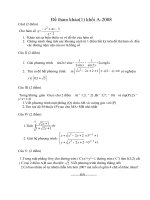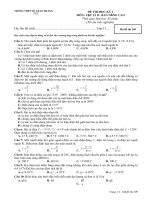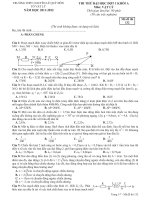Topic 1 Measuring a Nation’s Income
Bạn đang xem bản rút gọn của tài liệu. Xem và tải ngay bản đầy đủ của tài liệu tại đây (536.99 KB, 43 trang )
23
Measuring a Nation’s Income
PRINCIPLES OF
ECONOMICS
FOURTH EDITION
N. G R E G O R Y M A N K I W
PowerPoint® Slides
by Ron Cronovich
© 2007 Thomson South-Western, all rights reserved
In this chapter, look for the answers to
these questions:
What is Gross Domestic Product (GDP)?
How is GDP related to a nation’s total income
and spending?
What are the components of GDP?
How is GDP corrected for inflation?
Does GDP measure society’s well-being?
CHAPTER 23
MEASURING A NATION’S INCOME
1
Micro vs. Macro
Microeconomics:
The study of how individual households and
firms make decisions, interact with one another
in markets.
Macroeconomics:
The study of the economy as a whole.
We begin our study of macroeconomics with the
country’s total income and expenditure.
CHAPTER 23
MEASURING A NATION’S INCOME
2
Income and Expenditure
Gross Domestic Product (GDP) measures
total income of everyone in the economy.
GDP also measures total expenditure on the
economy’s output of g&s.
For the economy as a whole,
income equals expenditure, because
every dollar of expenditure by a buyer
is a dollar of income for the seller.
CHAPTER 23
MEASURING A NATION’S INCOME
3
The Circular-Flow Diagram
is a simple depiction of the macroeconomy.
illustrates GDP as spending, revenue,
factor payments, and income.
First, some preliminaries:
• Factors of production are inputs like labor,
land, capital, and natural resources.
• Factor payments are payments to the factors
of production. (e.g., wages, rent)
CHAPTER 23
MEASURING A NATION’S INCOME
4
FIGURE 1: The Circular-Flow Diagram
Households:
own the factors of production,
sell/rent them to firms for income
buy and consume g&s
Firms
CHAPTER 23
Households
MEASURING A NATION’S INCOME
5
FIGURE 1: The Circular-Flow Diagram
Firms
Households
Firms:
buy/hire factors of production,
use them to produce g&s
sell g&s
CHAPTER 23
MEASURING A NATION’S INCOME
6
FIGURE 1: The Circular-Flow Diagram
Revenue (=GDP)
G&S
sold
Markets for
Goods &
Services
Firms
G&S
bought
Households
Factors of
production
Wages, rent,
profit (=GDP)
CHAPTER 23
Spending (=GDP)
Markets for
Factors of
Production
MEASURING A NATION’S INCOME
Labor, land,
capital
Income (=GDP)
7
What This Diagram Omits
The government
• collects taxes
• purchases g&s
The financial system
• matches savers’ supply of funds with
borrowers’ demand for loans
The foreign sector
• trades g&s, financial assets, and currencies
with the country’s residents
CHAPTER 23
MEASURING A NATION’S INCOME
8
Gross Domestic Product (GDP) Is…
…the market value of all final goods &
services produced within a country
in a given period of time.
Goods are valued at their market prices, so:
• GDP measures all goods using the same units
(e.g., dollars in the U.S.), rather than “adding
apples to oranges.”
• Things that don’t have a market value are
excluded, e.g., housework you do for yourself.
CHAPTER 23
MEASURING A NATION’S INCOME
9
Gross Domestic Product (GDP) Is…
…the market value of all final goods &
services produced within a country
in a given period of time.
Final goods are intended for the end user.
Intermediate goods are used as components
or ingredients in the production of other goods.
GDP only includes final goods, as they already
embody the value of the intermediate goods
used in their production.
CHAPTER 23
MEASURING A NATION’S INCOME
10
Micro vs. Macro
Microeconomics:
The study of how individual households and
firms make decisions, interact with one another
in markets.
Macroeconomics:
The study of the economy as a whole.
We begin our study of macroeconomics with the
country’s total income and expenditure.
CHAPTER 23
MEASURING A NATION’S INCOME
2
Gross Domestic Product (GDP) Is…
…the market value of all final goods &
services produced within a country
in a given period of time.
GDP includes currently produced goods,
not goods produced in the past.
CHAPTER 23
MEASURING A NATION’S INCOME
12
Gross Domestic Product (GDP) Is…
…the market value of all final goods &
services produced within a country
in a given period of time.
GDP measures the value of production that occurs
within a country’s borders, whether done by its own
citizens or by foreigners located there.
CHAPTER 23
MEASURING A NATION’S INCOME
13
Gross Domestic Product (GDP) Is…
…the market value of all final goods &
services produced within a country
in a given period of time.
usually a year or a quarter (3 months).
CHAPTER 23
MEASURING A NATION’S INCOME
14
The Components of GDP
Recall: GDP is total spending.
Four components:
• Consumption (C)
• Investment (I)
• Government Purchases (G)
• Net Exports (NX)
These components add up to GDP (denoted Y):
Y = C + I + G + NX
CHAPTER 23
MEASURING A NATION’S INCOME
15
Consumption (C)
is total spending by households on g&s.
Note on housing costs:
• For renters, consumption includes rent
payments.
• For homeowners, consumption includes
the imputed rental value of the house,
but not the purchase price or mortgage
payments.
CHAPTER 23
MEASURING A NATION’S INCOME
16
Investment (I)
is total spending on goods that will be used in
the future to produce more goods.
includes spending on
• capital equipment (e.g., machines, tools)
• structures (factories, office buildings, houses)
• inventories (goods produced but not yet sold)
Note: “Investment” does not
mean the purchase of financial
assets like stocks and bonds.
CHAPTER 23
MEASURING A NATION’S INCOME
17
Government Purchases (G)
is all spending on the g&s purchased by govt
at the federal, state, and local levels.
G excludes transfer payments, such as
Social Security or unemployment insurance
benefits.
These payments represent transfers of income,
not purchases of g&s.
CHAPTER 23
MEASURING A NATION’S INCOME
18
Net Exports (NX)
NX = exports – imports
Exports represent foreign spending on the
economy’s g&s.
Imports are the portions of C, I, and G
that are spent on g&s produced abroad.
Adding up all the components of GDP gives:
Y = C + I + G + NX
CHAPTER 23
MEASURING A NATION’S INCOME
19
U.S. GDP and Its Components, 2005
billions
% of GDP
per capita
Y
$12,480
100.0
$42,035
C
8,746
70.1
29,460
I
2,100
16.8
7,072
G
2,360
18.9
7,950
NX
–726
–5.8
–2,444
CHAPTER 23
MEASURING A NATION’S INCOME
20
Income and Expenditure
Gross Domestic Product (GDP) measures
total income of everyone in the economy.
GDP also measures total expenditure on the
economy’s output of g&s.
For the economy as a whole,
income equals expenditure, because
every dollar of expenditure by a buyer
is a dollar of income for the seller.
CHAPTER 23
MEASURING A NATION’S INCOME
3
ACTIVE LEARNING
1:
Answers
A. Debbie spends $200 to buy her husband dinner
at the finest restaurant in Boston.
Consumption and GDP rise by $200.
B. Sarah spends $1800 on a new laptop to use in
her publishing business. The laptop was built in
China.
Investment rises by $1800, net exports fall
by $1800, GDP is unchanged.
22
ACTIVE LEARNING
1:
Answers
C. Jane spends $1200 on a computer to use in her
editing business. She got last year’s model on
sale for a great price from a local manufacturer.
Current GDP and investment do not change,
because the computer was built last year.
D. General Motors builds $500 million worth of cars,
but consumers only buy $470 million of them.
Consumption rises by $470 million,
inventory investment rises by $30 million,
and GDP rises by $500 million.
23
Real versus Nominal GDP
Inflation can distort economic variables like GDP,
so we have two versions of GDP:
One is corrected for inflation, the other is not.
Nominal GDP values output using current prices.
It is not corrected for inflation.
Real GDP values output using the prices of
a base year. Real GDP is corrected for inflation.
CHAPTER 23
MEASURING A NATION’S INCOME
24









